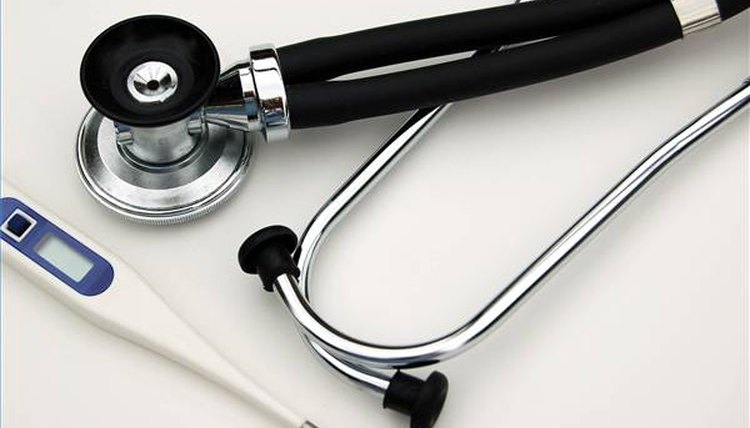How to Use a Dual Head Stethoscope

Use a dual head stethoscope without the confusion that commonly accompanies its use. Too often the double bell stethoscope is avoided because people are unfamiliar with it or the single bell stethoscope is simply easier to use. Adjust the stethoscope to increase comfort and maximize hearing. Learn when to use the small bell and the larger bell.
Clean the rubber ear pieces at the ends of the two metal arms with alcohol before inserting them in your ears. Do this every time it is used by someone else or may have become contaminated. Wait for the alcohol to dry. Separate the arms enough so that the ear pieces can slip into the outer ear canal. Put the ear pieces snugly in place. If there is pain or discomfort, discontinue use.
Avoid using a stethoscope that has arms pressing the ear pieces too hard. Pressing too hard into the ear canal creates pain and indicates that the stethoscope may be too small. Correct this problem and get a larger stethoscope. If the opposite is true and the ear pieces are not in firmly enough, get a smaller size.
Notice that the arms on the stethoscope rotate. Position the arms so they point slightly forward (to your anterior) as they enter the external ear canal.
Pick up the double bell (which looks like a double funnel) on the stethoscope. One side has a membrane over it (known as a diaphragm) and the other side is open. Look inside the open bell which has no diaphragm. Look in the lowest point inside the funnel while twisting the metal connector that attaches the bell to the tubes. Notice that in the deepest part of the open funnel, there is a hole that opens and closes as the connector (located between the bell and the rubber tubes) twists. When the hole is open, the bell without the diaphragm is ready for use. If the connector is twisted one hundred eighty degrees, the bell with the diaphragm is ready to use.
Press the bell firmly into the area to listen to after the bell of choice is activated proper position of the connector. While holding the tube, position the index finger over the center of the bell facing away from the patient. Double check the positioning of the bell.
Use the smaller bell for a more focused exploration of sound in a smaller area. The smaller bell also gives more detail by reducing the area covered and shutting out nearby sounds that a larger bell would pick up. Use the smaller bell to distinguish between subtle sounds in specific locations like a cardiologist or other medical staff. Use the other side of the bell (with the diaphragm) to listen to a less focused area inside of the chest cavity.
Tips
Select the proper position of the bell by twisting the connector. Do this improperly and the heartbeat will come from the bell pressed by your finger instead of the bell on the patient. Use the bell without a diaphragm by pressing lightly and the bell with the diaphragm by pressing more firmly for best results. Store the stethoscope with the diaphragm side selected for use to help keep out debris and allow immediate general use.
Warnings
Do not let loud sounds enter the bell while wearing the stethoscope since it could damage your hearing. Do not use the stethoscope if it is uncomfortable. Clean the earpieces before each use. Remove the rubber ear pieces to clean them well. Inspect the stethoscope before use to ensure that each piece is in good condition. Do not get the stethoscope wet, hot, or covered in corrosive chemicals. Do not immerse. Make sure that the tubing is long enough to operate comfortably when using the stethoscope for long periods of time.
